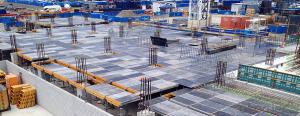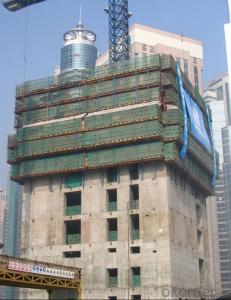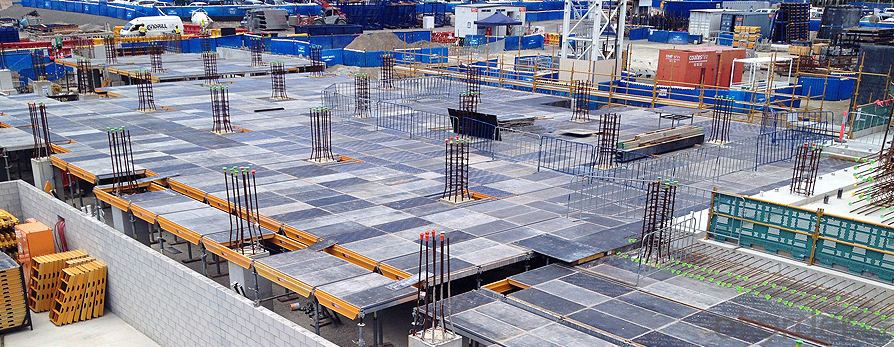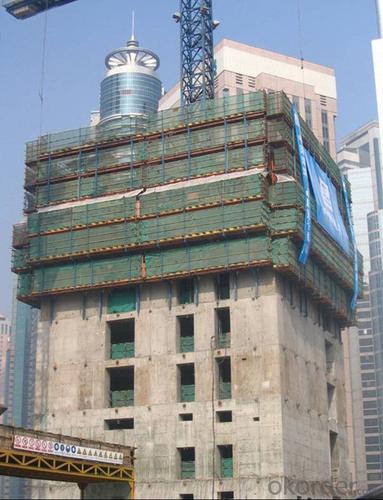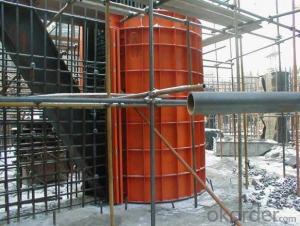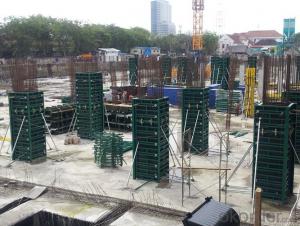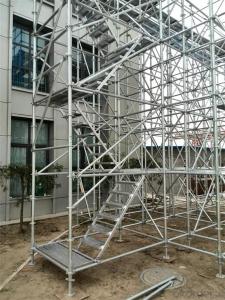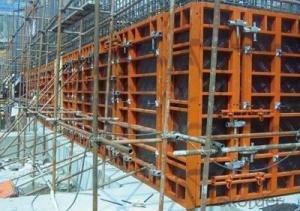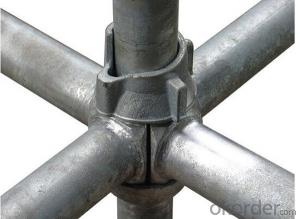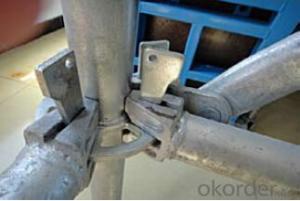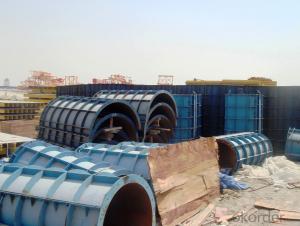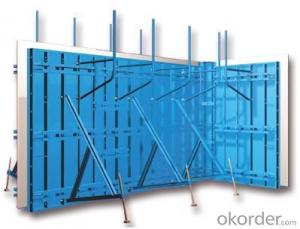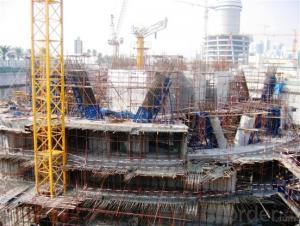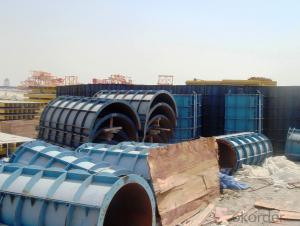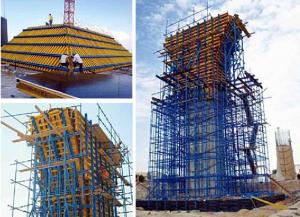Ringlock Scaffolding System Formwork Scaffolding Cover With New Design
- Loading Port:
- Tianjin
- Payment Terms:
- TT OR LC
- Min Order Qty:
- 5000 set
- Supply Capability:
- 50000 set/month
OKorder Service Pledge
OKorder Financial Service
You Might Also Like
Ringlock Scaffolding System Formwork Scaffolding Cover With New Design
Plastic Formwork Concrete Formwork Circular Column Used Scaffolding Props New Design
Developing with new technology materials, steel formworks is no longer a must in construction concrete process. More and more buildings are established with plastic formworks. And workers love this new formworks much more.
The advantages of plastic formworks:
Ringlock Scaffolding System Formwork Scaffolding Cover With New Design
1.First of all--light
Yes it is the first advantage of plastic formwork. It wins the great praise of both contractors and workers.
The biggest panel is 120×1500px,weights 10.5kg only. It can be lift and set up by one person easily, which means there is no need for cranes on site.Saves a lot of cost and time.
2.Easy set up
Different size of panels can firmly locked by simply turn the special handles to 90 degree. The Panels has rib on the back, which makes the system need not traditional wood blocks and nails. The panels have holes to fit tie rod, guarantee the strength of the whole system.
3.Modularity
Modular formworks composed by different size of panels,the main item is 120×1500px panel,which is used for the large area of walls and slabs. There are also small size of panels like 10×1500px,20×1500pxcm,25×1500px,inner corner 20×20×1500px and outer corner 10×5×1500px.Due to the variety of panel size, the system can form almost all size walls 120×1500px panel of multiply by 125px. The material of modular formwork is PC-ABS mixed with special glass fibers which enable panels to hold high pressures.
4.Strength
The handles are made by high strength Nilon, each panel locked by at least 4 handles, which makes the whole system strong enough to pour 1000px walls.
5.Environment friendly
The system needs no cut and nail due to the variety size. Also it needs nearly no wood. The material can be recycled after broken, so it will not pollute the environment.
6.Consequent
Concrete does not stick to plastic formwork, thus the panels need no oil before using, and can be cleaned simply by water. The surface of the wall which build by modular formwork is smooth and without rework.
.Ringlock Scaffolding System Formwork Scaffolding Cover With New Design
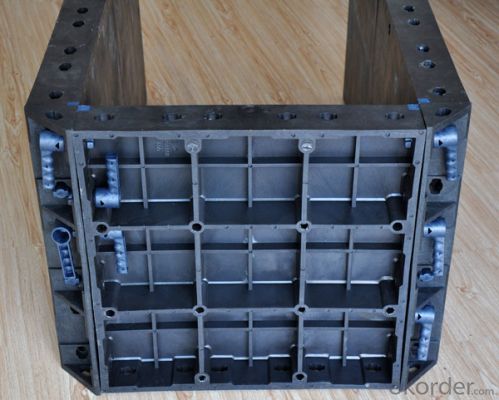
Ringlock Scaffolding System Formwork Scaffolding Cover With New Design
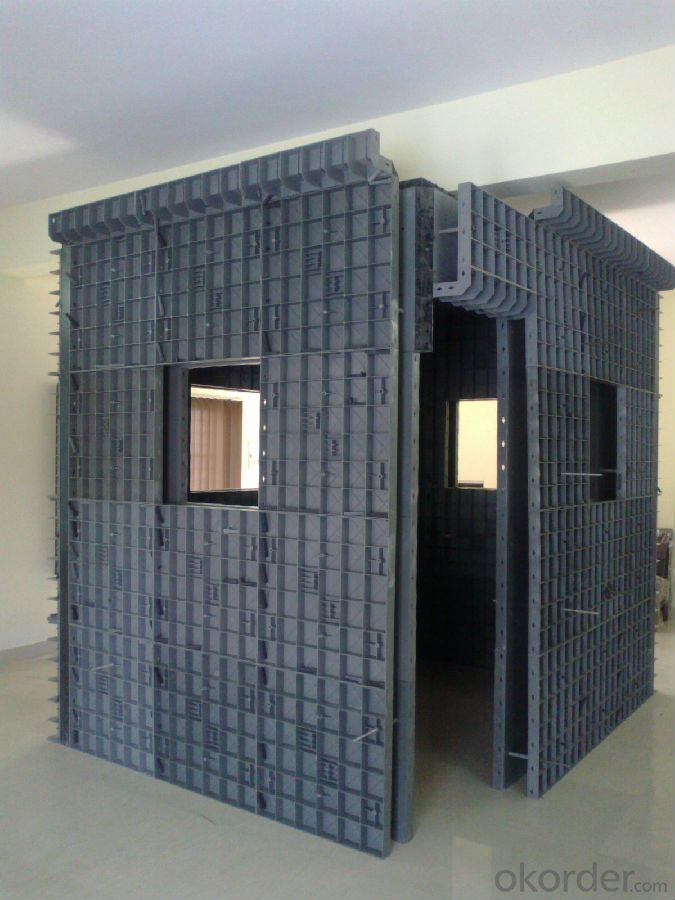
Ringlock Scaffolding System Formwork Scaffolding Cover With New Design
Advantage
* Good loading capacity
* Easy to assemble and dismantle
* Stable and durable thanks to its structual design & automatic welding quality
* Customized solution helps you work safe, save cost and convenient
* Excellent quality for formwork & scaffolding with wide choices
Ringlock Scaffolding System Formwork Scaffolding Cover With New Design
Packing
in bulk or in bundle, or as requested
Shipping
15-20 Days.
Normally small orders, it needs just 15-20 business days to the port. For goods with stock, it would be even shoter.
Ringlock Scaffolding System Formwork Scaffolding Cover With New Design
Other scaffolding & formwork products:
(1) Scaffolding System:
Including Ringlock Scaffolding System and accessories; Cuplock Scaffolding System and accessories; Kwikstage Scaffolding System and accessories; Haki Scaffolding System and accessories;
(2) Scaffolding Frame & Accessories:
Including Walk Through Frame Scaffolding; Ladder Frame Scaffolding; Accessories; we also can make scaffolding according to your samples or drawings.
(3) Scaffolding Couplers/Clamps:
We can produce all kinds of forged and pressed couplers, including British type couplers, American type couplers, German type couplers, Italian type couplers ,fence couplers, BRC coplers and so on. We also can produce according to your drawings or samples.
(4) Formwork System Scaffolding & Accessories:
Light Duty Shoring prop and Heavy Duty Shoring Prop; Wing nuts and Tie rods; RASTO clamp and so on.
FAQ Ringlock Scaffolding System Formwork Scaffolding Cover With New Design
Why Us?
We are one of the Top 500 in the world, largest construction materials supplier in China. Also we are a state-owned company and respond to every customer with large and also small orders.
We own professional manufacturers with powerful producing capacity.
Extensive and comprehensive quality control system
Excellent products with competitive prices.
Efficient services in pre and after sale.
Full energy with affluent experience team.
- Q: What are the different types of accessories and attachments available for steel frame formwork?
- There are several different types of accessories and attachments available for steel frame formwork. These accessories and attachments are designed to enhance the functionality and efficiency of the formwork system and make the construction process smoother. One of the most common accessories is the adjustable prop. Adjustable props are used to support the formwork system and ensure its stability. These props can be easily adjusted to different heights, allowing for flexibility in construction projects. Another important accessory is the formwork clamp. Formwork clamps are used to securely fasten the formwork panels together, preventing any movement or displacement during the concrete pouring process. Formwork brackets are also commonly used accessories. These brackets are attached to the steel frame formwork and help to support the formwork panels and beams. They provide additional stability and strength to the system. Other accessories include formwork connectors, which are used to connect the formwork panels together, and formwork ties, which are used to secure the formwork system to the structure being constructed. In addition to these accessories, there are also various attachments available for steel frame formwork. One example is the formwork corner, which is used to create sharp corners and angles in the formwork system. This attachment ensures that the formwork system can be adjusted to fit the specific design requirements of a construction project. Another attachment is the formwork bracket arm. This arm is used to extend the reach of the formwork brackets, allowing for greater flexibility in formwork placement. Overall, the different types of accessories and attachments available for steel frame formwork are designed to enhance the stability, flexibility, and functionality of the system. These accessories and attachments help to create a more efficient and effective construction process, resulting in a higher quality finished product.
- Q: Can steel frame formwork be used in projects with limited access or space constraints?
- Yes, steel frame formwork can be used in projects with limited access or space constraints. Steel frame formwork is known for its versatility and adaptability, making it ideal for constrained construction sites. Its modular design allows for easy assembly and disassembly, which is beneficial in areas with limited space or difficult access. Additionally, steel frame formwork can be easily adjusted or modified to fit various project requirements, ensuring efficiency in construction even with limited access or space constraints.
- Q: Are there any limitations to the shape or design of structures that can be constructed using steel frame formwork?
- Steel frame formwork does have limitations in terms of shape and design of structures that can be built. It is a widely used and versatile construction technique, but certain considerations must be made during the design phase. One limitation is the difficulty in constructing curved or irregular shapes. Steel frame formwork works best for structures with straight lines and right angles. Building complex curved or irregular shapes can be challenging and may require customization and additional fabrication. Another limitation is the size and weight of the structure. Steel frame formwork can handle large and tall structures, but there are practical limits to the achievable size and weight. The weight of the formwork and the concrete being poured can strain the steel frames and supports, necessitating careful engineering to maintain structural integrity. Additionally, the height and depth of the structure can be limiting factors. Steel frame formwork systems are typically modular and adjustable, but there are practical limits to the attainable height and depth. Beyond a certain point, additional support systems may be necessary for stability and safety. Lastly, the aesthetic design of the structure may be constrained by the use of steel frame formwork. While finishes and cladding materials can be applied to the formwork, the exposed areas will still have a distinct steel frame appearance. This may not be suitable for certain architectural designs that require a different aesthetic. In conclusion, steel frame formwork is a versatile construction technique, but it does have limitations in terms of shape, size and weight, height and depth, and aesthetic design. These limitations should be carefully considered during the design phase to ensure the practicality and feasibility of using steel frame formwork for a specific structure.
- Q: What is the steel frame center support structure
- The steel frame belongs to the steel structure, and belongs to the frame structure. According to the framework, the design and construction of steel structure
- Q: How does steel frame formwork help in achieving accurate concrete thickness?
- Achieving accurate concrete thickness is made possible through the use of steel frame formwork, which provides a rigid and stable structure for pouring and shaping the concrete. Acting as a mold or template, the steel frame holds the wet concrete in place until it sets and hardens. One of the primary benefits of steel frame formwork is its resistance to deformation or movement during the pouring and curing process. This guarantees that the concrete maintains its intended thickness and shape, leading to precise and consistent outcomes. Furthermore, the steel frame formwork allows for precise control over the dimensions and alignment of the concrete. It can be adjusted and leveled to the desired thickness, ensuring that the concrete is poured to the correct depth. This feature is particularly crucial in applications where specific thickness requirements are essential, such as in constructing walls, slabs, or columns. Moreover, the steel frame formwork provides a smooth and even surface finish to the concrete. The sturdy structure of the steel frame prevents any bulges, warping, or irregularities, resulting in a uniformly thick concrete structure. This not only enhances the aesthetic appeal of the final product but also ensures its structural integrity. In summary, steel frame formwork plays a vital role in achieving accurate concrete thickness by offering stability, precision, and control throughout the pouring and shaping process. Its resistance to deformation and ability to maintain dimensional accuracy guarantee that the concrete meets the required thickness specifications, resulting in resilient and high-quality structures.
- Q: What are the different types of accessories used with steel frame formwork?
- Steel frame formwork systems commonly utilize various accessories to enhance efficiency and effectiveness, as well as provide additional support and stability to the structure being formed. One frequently used accessory with steel frame formwork is the form tie. Form ties are employed to prevent the spreading apart of formwork panels under concrete pressure, effectively holding them together. Typically constructed from steel, form ties are available in different lengths to accommodate varying formwork heights. Another significant accessory is the formwork clamp, which securely fastens formwork panels to the steel frame, ensuring they remain in place during concrete pouring and curing. Formwork clamps come in different sizes and designs to suit various formwork configurations. Strong and durable formwork props or scaffolding are also necessary for supporting the weight of formwork panels and freshly poured concrete in steel formwork. These adjustable props provide stability to the formwork system and are typically made of steel, varying in size and load-bearing capacities. Additional accessories used in steel frame formwork include corner connectors for connecting formwork panels at 90-degree angles, and formwork release agents to prevent concrete from adhering to the formwork surface. Furthermore, accessories like formwork liners can be utilized to create different surface finishes on the concrete, while chamfer strips can produce beveled edges and smooth transitions between different formwork sections. In conclusion, the diverse range of accessories employed in steel frame formwork is aimed at delivering stability, support, and ease of use, ultimately ensuring the efficient and effective function of the formwork system during the concrete pouring process.
- Q: How to define the structural system of the upper part of the bottom steel frame
- (PS: regarding the specification and selection of structure types, characteristics and structure as well as the earthquake was not simply that, according to the above statement set must be correct, need further discussion.)Framework modeling: frame "to 3D model and load model, input directory is still just entered, can see the program automatically generates each standard layer on top of the roof also automatically set the" node on high". This is why I suggest to use the portal frame modeling, which can skew and variable cross-section beam generating top-level conveniently.
- Q: What are the different types of connection brackets used with steel frame formwork?
- There are several different types of connection brackets used with steel frame formwork, including wedge brackets, hook brackets, and pin brackets. These brackets are used to securely connect the formwork panels together, ensuring stability and strength during the concrete pouring process.
- Q: What are the considerations for selecting the appropriate formwork for different concrete mixes?
- When selecting the appropriate formwork for different concrete mixes, there are several considerations that should be taken into account. These considerations include the type of concrete mix, the desired finish of the concrete surface, the required strength of the structure, the complexity of the formwork design, and the availability and cost of the formwork materials. First and foremost, the type of concrete mix being used is an important factor. Different mixes have varying properties, such as workability, setting time, and shrinkage. For example, if a concrete mix has a high workability, it may require a more rigid and stable formwork system to prevent bulging or deformation during pouring and curing. On the other hand, a mix with low workability may require a more flexible formwork system that can accommodate the limited flow of the concrete. The desired finish of the concrete surface is another consideration. If a smooth and aesthetically pleasing finish is required, the formwork should be able to provide a tight and smooth surface without any deformities or marks. This may require using formwork materials that are resistant to moisture absorption or have a smooth surface finish themselves. Alternatively, if the finish is not as critical, less expensive and simpler formwork options may be suitable. The required strength of the structure also plays a role in formwork selection. If the structure needs to withstand high loads or have a long service life, the formwork should be able to withstand the pressure exerted by the concrete during pouring and curing. This may involve using stronger and more durable formwork materials, such as steel or engineered wood, as opposed to traditional timber formwork. The complexity of the formwork design is another consideration. If the structure has intricate shapes or unique geometries, the formwork system needs to be able to accommodate these complexities. This may require using adjustable formwork systems, modular formwork components, or custom-made formwork. It is important to select a formwork system that can be easily assembled and disassembled to ensure efficient construction. Lastly, the availability and cost of the formwork materials should be taken into account. Some formwork materials may be readily available in certain regions, while others may need to be imported or specially ordered. Additionally, the cost of the formwork materials can vary significantly, depending on the type and quality. It is essential to consider the budget constraints and the overall cost-effectiveness of the formwork system. Overall, selecting the appropriate formwork for different concrete mixes requires a careful evaluation of factors such as the type of mix, desired finish, required strength, complexity of design, and cost considerations. By considering these factors, one can choose the most suitable formwork system that ensures efficient construction and meets the specific requirements of the project.
- Q: How does steel frame formwork contribute to better concrete compaction?
- There are several ways in which steel frame formwork enhances concrete compaction. To begin with, the inflexible and robust nature of steel frame formwork offers a stable and sturdy support system for the concrete during pouring and compaction. This guarantees that the concrete maintains its desired shape and position, preventing any deformity or displacement that could compromise its strength and durability. Furthermore, steel frame formwork is designed with precision and accuracy, allowing for accurate alignment and leveling of the formwork. This results in even and uniform pouring of the concrete, facilitating improved compaction. Inconsistent pouring can lead to irregularities in the density and strength of the concrete, potentially causing structural problems in the future. Moreover, steel frame formwork often incorporates adjustable features like telescopic struts or clamps, which enable tight and secure fastening of the formwork. This minimizes any movement or vibration of the formwork during the compaction process, leading to better consolidation of the concrete. Adequate consolidation is crucial in eliminating air voids and excess water from the concrete, resulting in a denser and more durable final product. Additionally, steel frame formwork typically possesses smooth surfaces and clean edges, which allows for effortless removal of the formwork once the concrete has set. This smoothness helps prevent any drag or drag marks during the removal process, which could adversely affect the quality of the compaction. In conclusion, steel frame formwork enhances concrete compaction by providing a stable and sturdy support structure, ensuring accurate alignment and leveling, facilitating tight and secure fastening, and allowing for easy removal without compromising the quality of the compaction.
Send your message to us
Ringlock Scaffolding System Formwork Scaffolding Cover With New Design
- Loading Port:
- Tianjin
- Payment Terms:
- TT OR LC
- Min Order Qty:
- 5000 set
- Supply Capability:
- 50000 set/month
OKorder Service Pledge
OKorder Financial Service
Similar products
Hot products
Hot Searches
